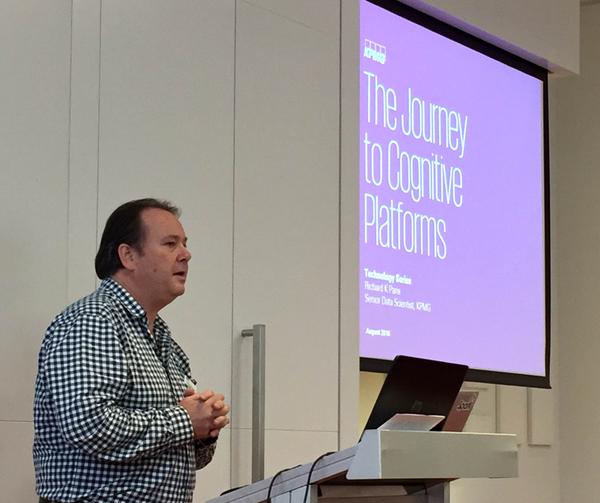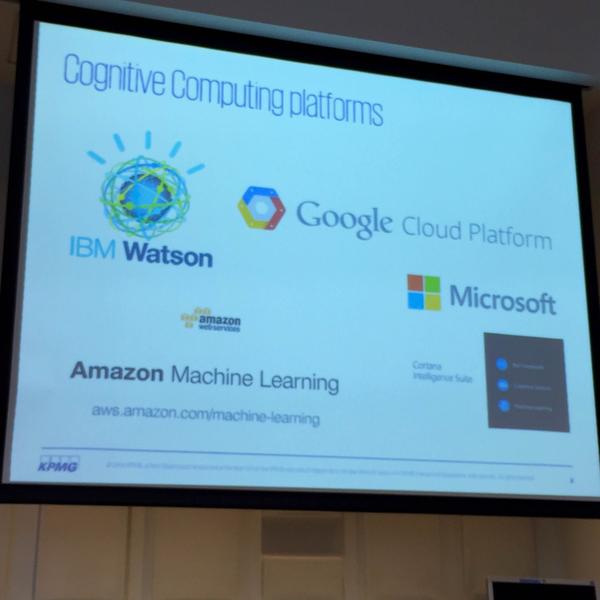Cloud plus artificial intelligence = future
- 26 August, 2016 07:00

Technology around us will provide an “augmented intelligence” that will help humans to make smarter decisions, improve business models and solve problems that were previously intractable.
“The ways in which we are able to interact with computers is going to make people a lot more efficient and more effective, and build digital models.”
This, says Richard Paris, senior data scientist at KPMG New Zealand, is the future of digital.
We are increasingly seeing the digital world interact in our everyday lives, says Paris, who spoke at the inaugural KPMG Technology Series in Auckland.
People interact with smartphones and these devices are becoming our intelligent assistants.
“We are moving into the Internet of Things (IoT),” he adds. “We are surrounded by devices getting data from us, so we interact with them.”

We are moving into the Internet of Things... We are surrounded by devices getting data from us, so we interact with them.
This convergence leads to the rise of cognitive computing.He defines cognitive computing as artificial intelligence that feeds on Big Data.
“Cognitive computing redefines the nature of the relationship between people and their increasingly pervasive digital environment.”
The notion of cognitive implies being biologically inspired, such as with speech recognition software.
It covers language, vision, speech, prediction, knowledge, data insights and search.
“You can take existing systems and enhance them,” he says.
The machines can learn from data and come out with strategies and solutions from the data.
This is demonstrated by chatbot, he says. “With chatbot, you actually have an intelligent conversation with a machine that is able to get facts and offer solutions.”
“What makes it significant is that machines are able to transfer their learning based on their specific context, so that the context gets wider and deeper and much faster than one machine in a specific environment,” says Paris.
“We will have these machines in different environments and when you combine them like a kind of brain, you are distributing the learning … and when it is distributed, that learning becomes much broader and more robust.”
He cites how machine learning is already being applied by the legal profession.
“Machines get very good at learning about contract structures and understanding that for a given contract structure, what the risk or weak points in the contract could be,” he says. “Under what conditions could one party sue the other and most likely be successful?”
Lawyers are starting to use it for litigation to basically, based on the previous legal arguments, determine what is the likelihood of even winning the case.
Before you even go to court, you can run it through the software, and based on machine learning, look at all the precedents and the factors that will show the likelihood of winning the case using a particular line of legal argument.
Or the machine can suggest an alternative argument, he states.
“That is really clever. The machine is getting the ability to reason and the cognition piece is combining things like sight, sound or listening to create and recommend an alternative strategy."

Cloud is not magic
Another speaker, Jeff McLuckie, KPMG cloud architect, spoke about the opportunities for businesses to transform through the cloud.
It is critical for organisations to start with a strategy. “Answer the big questions upfront,” he says, “It is not just about the technology.”

Constantly optimise and improve what you are doing. Once you are up there, you need to be on a constantly improving cycle
He lists some initial questions:
“What business problem will cloud enable us to solve? What are our competitors doing? What should I move to the cloud and how much will it cost me? Will my existing operating model be impacted? If so, how do I transform?”
The organisation should also consider regulatory, compliance and security requirements, he states.
“Is the cloud solution in compliance with the different industry regulations? How do I architect security to protect against cybersecurity threats?”
The third area to consider covers architecture and integration, he says.
“What are the business and technical requirements for cloud? What is my architecture design for a hybrid cloud? What is my vendor ecosystem? How does cloud impact my enterprise architecture and information management?
“The cloud is giving you more capability for new and exciting stuff,” he says, “do something different, make the most of what you can possibly do.”
He says questions need to be answered around management of the hybrid cloud environment.
“Will it affect the existing environment and resources? How do I ensure I reap the operational benefits of cloud? Should I adopt DevOps? How and when should I migrate application workloads to the cloud?”
He lists the steps organisations can take:
●Build your case and get buy in - what are the financial components, how much will it cost?
●Pick a cloud service to meet the problem.
● Identify and address skill gaps.
●Figure out the financials and administration. “Think long term,” he states. ''What part of the organisation pays for that? Figure it out upfront.”
●Pick some test subjects (“not just one”) for a proof of concept. Pick about three, go back to the business and say, this is what we are going to move.
●Get formal approval - depending on what you are intending to move, the first cab off the rank is not sensitive stuff.
●Design and plan. “Who is going to run it? This is where technology people get excited.”
●Implement. “The fun part where you go and do stuff.”
●Then, test, document, review and improve.
“Make sure you are documenting what you are doing. Get feedback and ask how can we improve the process?”
The next steps should be around integrating with the management tools; identifying issues and gaps in capability; monitoring usage, performance and cost; then breaking it and seeing what happens.
“Optimise, optimise, optimise,” he states. Review the strategy, identify the next set of subjects, then repeat the process.
“Constantly optimise and improve what you are doing. Once you are up there, you need to be on a constantly improving cycle,” he says. “The cloud has gone to doing cool stuff we couldn’t do before, like machine learning.”
However, at any stage you may say it is not working and that is a perfectly valid decision, he says.
It is important to know the skill gaps when implementing the cloud he says. “Does your team or operating model need to change?”
The people you have now, have organisational knowledge and know your systems, he says. “Bring them along [on] the upskilling journey.”
He ends his presentation by busting “cloud myths”.
First is that the cloud is always about money. “It is about capability and agility and to quickly implement new stuff,” he says.
Another is that the cloud is not for mission critical systems. “Some organisations have their entire businesses operating on cloud,” he states.
“Cloud is not magic,” concludes McLuckie. “It still requires discipline, planning and expertise.”

Send news tips and comments to divina_paredes@idg.co.nz
Follow Divina Paredes on Twitter: @divinap
Follow CIO New Zealand on Twitter:@cio_nz
Sign up for CIO newsletters for regular updates on CIO news, views and events.

